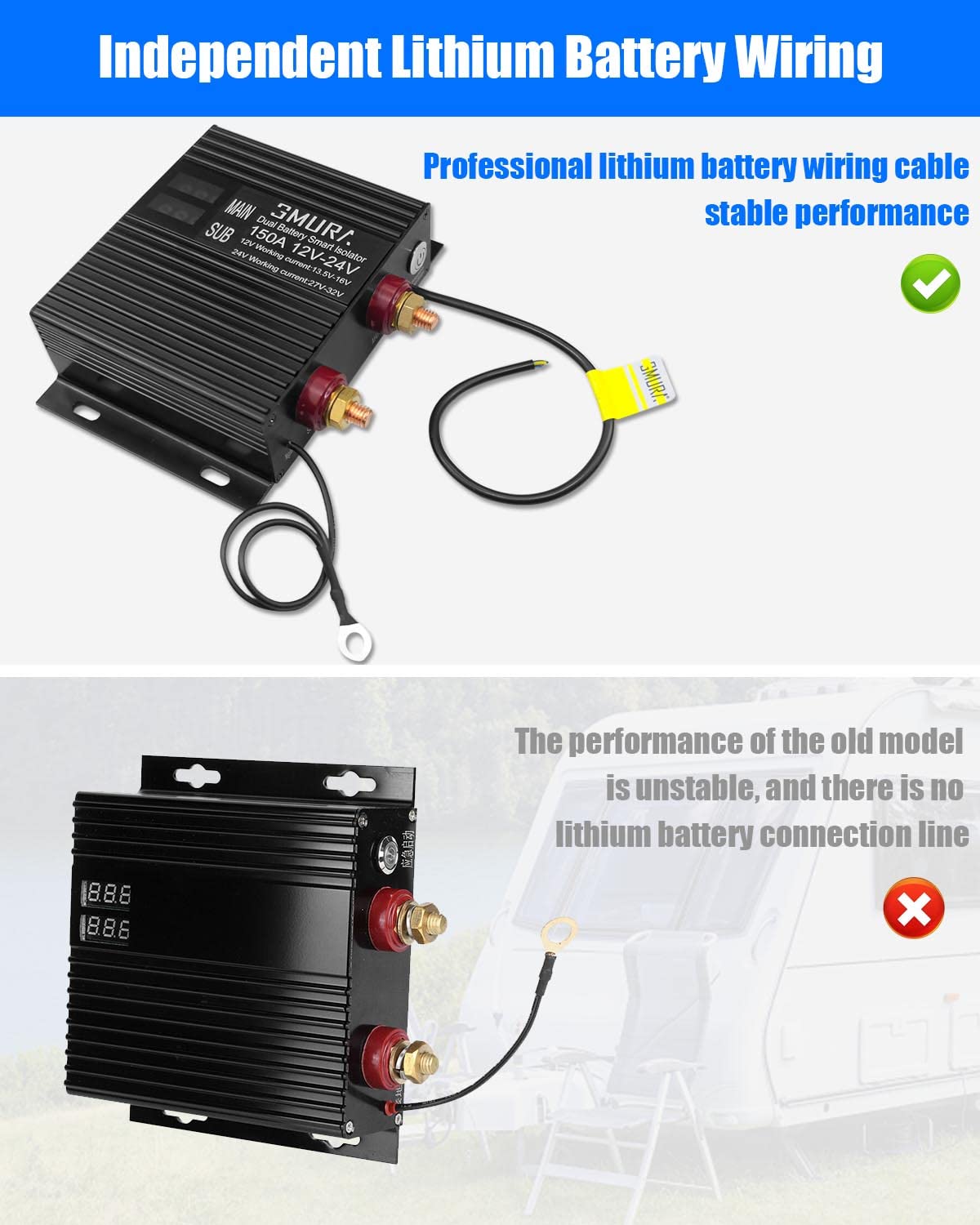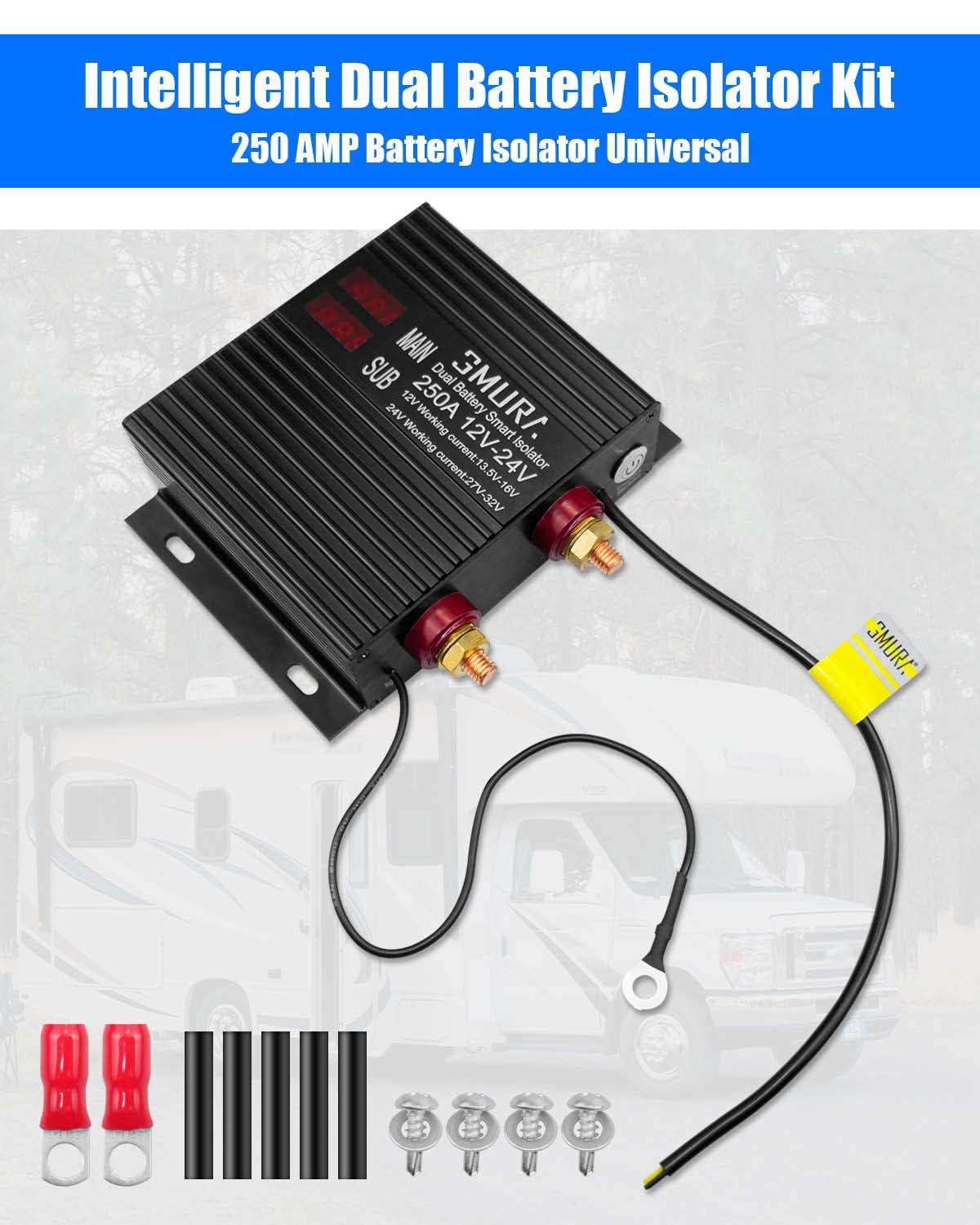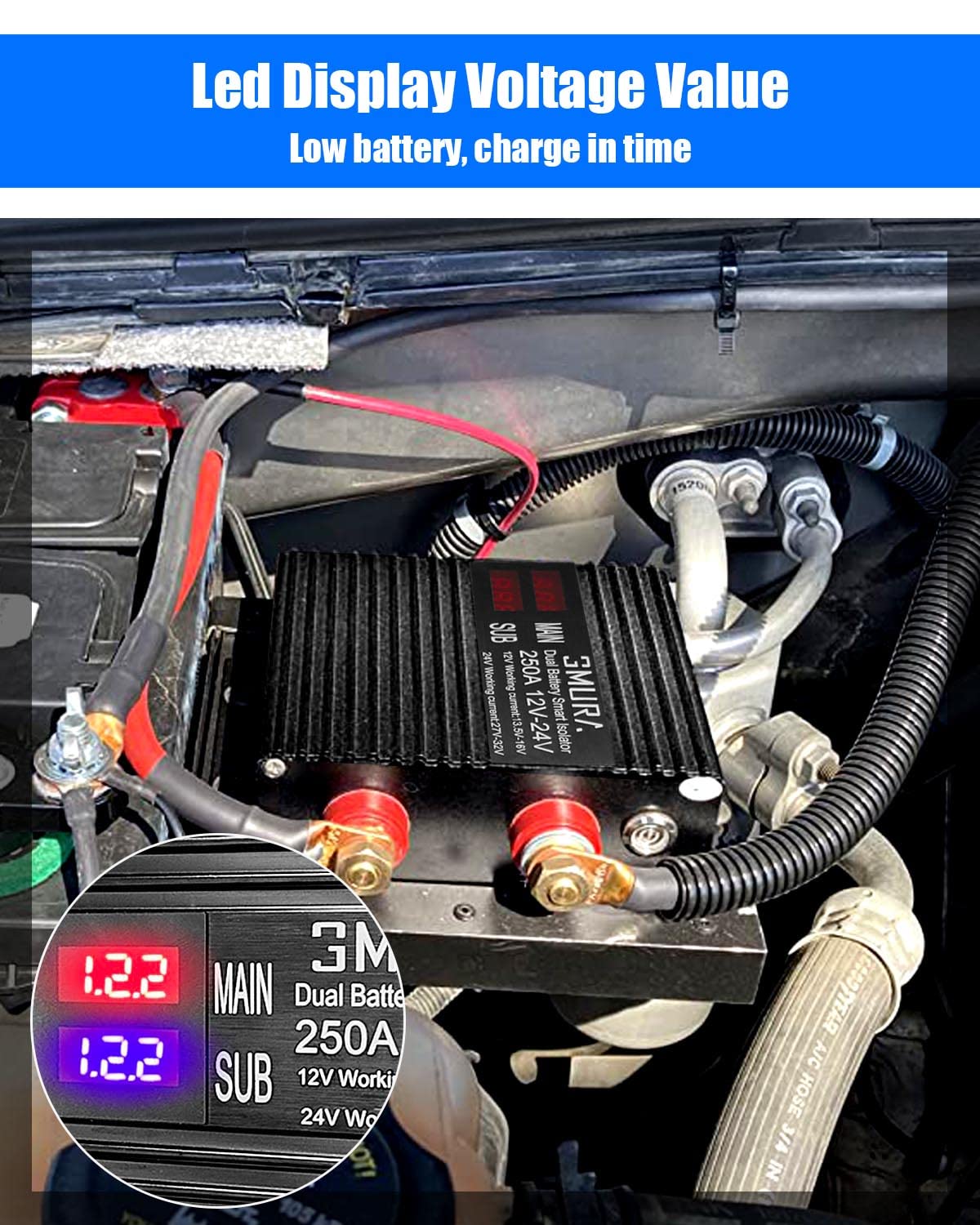- Clever Design: High current 150 amps, universal voltage 12V/24V, LED display can monitor the voltage of two batteries in real time, equipped with emergency button, if the engine cannot be started when the primary battery is dead, just press the emergency button to turn on the auxiliary battery to start the engine
- Voltage Display: After connection, the voltage display is 13.5V-16V (12V working voltage), 27V-32V (24V working voltage), battery isolator will disconnect immediately when it is lower than 12.5V, NOTE: There is a 5 second delay when the product is automatically connected or disconnected
- Applicable to Lithium Batteries: The dual battery isolator adds a lithium battery connection cable, so it can be applied to vehicles with lithium batteries to maintain the stable performance of the car battery, this product has 4 fixing holes for easy installation
- Full Coverage: Dual battery isolators ensure the main battery is always charged and ready to start the vehicle, just like your vehicle has two independent power sources for each battery and only one alternator
- Wide Range of Applications: The battery isolation kit is designed to be small and exquisite, does not take up space, and is compatible with a variety of vehicles, such as 12V/24V trucks, ATVs, UTVs, boats, RVs, vans, SUVs, campers, etc
 Battery Alligator Clips,10AWG Battery Charger Clamps.SAE Quick Release Adapter to Alligator Clips.Sae to Alligator Clips Extension Charging Cable for Cars Motorcycles.(NEW)
*$324.30
Battery Alligator Clips,10AWG Battery Charger Clamps.SAE Quick Release Adapter to Alligator Clips.Sae to Alligator Clips Extension Charging Cable for Cars Motorcycles.(NEW)
*$324.30
 Jumper Cables with Adapter for Milwaukee M18 18V Batteries, 8AWG 5.9FT Jump Starter Auto Booster Cable for Jump Starting Car Using Tool Battery
*$517.00
Jumper Cables with Adapter for Milwaukee M18 18V Batteries, 8AWG 5.9FT Jump Starter Auto Booster Cable for Jump Starting Car Using Tool Battery
*$517.00
Frete Grátis em todo o BrasilProduto Original Importado dos EUA
150 Amp Dual Battery Isolator Kit, Dual Battery Smart Isolator Universal 12v/24v Voltage Sensitive Relay for Car RV ATV UTV Camper Truck Boat Off-Road Vehicles Heavy Duty Power…
*$841.00
Informação adicional
| Operation Mode | Automatically |
|---|---|
| Current Rating | 150 Amps |
| Operating Voltage | 12 Volts |
| Contact Type | Normally Open |
| Connector Type | Auxiliary |
| Brand | GMURA |
| Terminal | Screw |
| Circuit Type | 1-way |
| Actuator Type | Ignition |
| Contact Material | Copper |
| Switch Type Button | Switch Type Button |
| Mounting Type Panel Mount | Mounting Type Panel Mount |
 Frete Grátis em todos os produtos
Frete Grátis em todos os produtos
















Peter Holley –
Once I found a spot to attach the device it was very easy to wire up. Attaching it the chassis was the hard part.
Apparently you do not need the red wire connected unless using a lithium battery.
The instructions say that the yellow and black wire go to a switch to manually connect the batteries. I found that the black wire is just ground so I only needed to run one wire to the switch with the other end locally grounded. I used the same ground to install an indicator from the blue wire. Now I can see that the batteries are connected with the indicator.
It seems that the solar charger for the house battery may also activate it as well so the chassis gets charged. I’ll update if I find that I’m mistaken on this.
I did find the instructions for the blink patterns to be not super helpful .
Piet S. –
Installed it more than a month ago and it is still working fine.
terry –
Think of the yellow wire as a remote emergency start switch. If you bury the dual battery isolater somewhere where you can’t reach the emergency start switch the remote borrow wire (yellow) can be used as a remote emergency start switch on your vehicles dash. The yellow wire when connected to ground (switched on) causes the car battery to connect/borrow from the auxiliary battery to start the car. After car starts turn borrow switch off so batteries are isolated again. Blue wire powers a light to indicate your batteries are connected (in borrowed mode) light on. When in isolated mode light is off. Blue wire connects to one side of the light and the outside of light to black/ground wire. Red wire is for lithium battery auxiliary only. In lithium battery use connect the red wire to the ACC (accessory side of the ignition switch). When you insert the key into the ignition switch and turn it to the left you are turning on the ACC circuit. This connection helps maintain the stable performance of the car battery. It took a lot of reading/research to figure what they mean by borrow switch. Hope this helps.
George M. Dudash –
I purchased this unit to install in my 2017 Thor Citation motor home. We purchased the RV used and I noticed that the house batteries would only charge up, on shore power. The engine alternator did not connect to the house batteries at all. I investigated whether or not they SHOULD be charging but only got mixed information from the RV forums. I decided that I would just bite the bullet and install one of these, no matter what.
As it turns out, the Thor Citation IS equipped with a solenoid that is supposed to connect the two battery systems together when the alternator is working. BUT my solenoid was bad.
I could have cheaped out and just bought a simple starter solenoid to replace the one that came with the coach, but that one failed; Probably due to arcing when the mechanical contacts made and broke each time the vehicle was started. So instead, I just removed the old solenoid and replaced it with this solid state unit. It was EASY. The job took just a few minutes to swap existing wiring. If the wonderful “German Engineering” hadn’t hidden all of this under the driver’s seat of the RV, I would have been done in 15 minutes instead of an hour.
We’ll see how long it lasts, but SO FAR SO GOOD.
I dinged the unit one star because, as others have already stated, the “emergency start button” is located on the same panel that the connections are on???? C’mon guys. The meter and buttons should NOT be on the same panel as the high current connectors! I could have installed the box next to the side panel of the seat and had easy access to the display and the button if they had only been on a side by themselves.
RGB –
Seller unfamiliar with , or not knowledgeable on the product. The Isolator, is powered by the Car Battery: The Main battery. It draws power, and gets very hot when in use. After waking up, it remains “in use” with lights on and radiating body very hot for most of a day. That draws power from the Main Battery. This unit has killed a brand new AGM car battery. I would have expected this to draw power from the secondary battery. The whole idea of the unit is to ensure that the main battery is not drained. That is why it isolates the main battery from the load on the secondary battery. This unit is itself a load, and over a few weeks it kills the battery. Repeated draining, will mean needing to buy a new battery.
After reaching out to the seller, and repeatedly answering questions he asked, the seller just fades out.
He may have refunded my money originally. I don’t remember and the invoice is confusing. BUT that refund was due to the pain it was to figure out what their awful microscopic instruction card in the box, said. Many here complained about that. Eventually I figured it out, and installed it, only to find that it is killing the main battery!
Paul –
I have this installed in my vehicle containing the main lead acid starting battery and lithium iron phosphate battery for my solar installation. I have the solar controller connected directly to the lithium battery and during long idle time it eventually connects both batteries so both batteries always stay charged. Also, when vehicle engine is started the lithium battery is connected to the starting battery so both can charge but there is a slight delay so the secondary battery won’t get damaged during cranking the engine. This device works 100% as it should as long as it is correctly installed with one of the wires going to the ignition positive connection.
AJ Sanborn –
So far it works perfectly. Does what it’s supposed to. Would purchase again.
Jim T. –
I most likely would have awarded this Dual Battery Isolator 5 stars if the instructions were not so confusing and contradicting! Before ordering, I watched the Charlie Chaplen style silent instruction vedeo several times, it never mentioned the need to purchase a 300 amp fuse (which delayed the completion of the install by 4 days) and the explaination of the addtional black wire contradicted the poorly written printed instructios!
Sure wish there was an American made alternative!